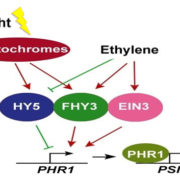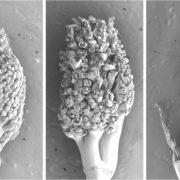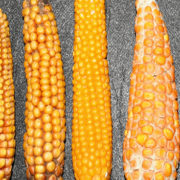
Light Helps Plants Cope with Phosphate Starvation
Research, The Plant Cell, The Plant Cell: In a NutshellLiu et al. focus on transcriptional regulation of PHR1 expression. The Plant Cell 2017. https://doi.org/10.1105/tpc.17.00268
Phosphorus (P) is an essential micronutrient for plant growth, development, and metabolism. Phosphate (Pi), the major form of P used by plants, is highly immobile in most soils,…

How Does Histone Phosphorylation Affect Flowering Time?
Research, The Plant Cell, The Plant Cell: In a NutshellSu et al. look at chromatin modifications that affect flowering. The Plant Cell 2017. https://doi.org/10.1105/tpc.17.00266
Plants, unlike animals, begin their lives as seeds that – in flowering plants – develop from flowers. This depends upon proper regulation of flowering time, to ensure pollination,…

Getting It Done On Time: How Maize Orders DNA Replication
Research, The Plant Cell, The Plant Cell: In a NutshellWear et al. examine replication programs in plants. The Plant Cell 2017. https://doi.org/10.1105/tpc.17.00037
By William Thompson, Emily Wear, and Linda Hanley-Bowdoin
DNA replication is fundamental to all life, as it is the process by which genetic material is duplicated so it can be passed from…

Tiny Mutation Linked to Tastier Tomatoes
Research, The Plant Cell, The Plant Cell: In a NutshellYe et al. discover a gene affecting tomato flavor. The Plant Cell 2017. https://doi.org/10.1105/tpc.17.00211
By Jie Ye
Malate—a widely occurring organic acid in plants—is an important contributor to taste. Variation in acid content has a much greater impact on flavor than does the limited…

Translating to beat the heat
Research, The Plant Cell, The Plant Cell: In a NutshellZhang et al. investigate protein translation under heat stresss http://www.plantcell.org/content/29/8/1952
By Elizabeth Vierling
Plants can’t move to avoid unfavorable growth conditions, such as insufficient water availability or extremes of temperature. When plants are confronted with stressful…

From Light to Food – Organization of Photosynthetic Complexes
Research, The Plant Cell, The Plant Cell: In a Nutshell0 Comments
/
MacGregor-Chatwin et al. map the cellular organization of photosynthetic protein complexes http://www.plantcell.org/content/29/5/1119
Life on Earth depends on photosynthesis, the source of all of our food, oxygen, and most of our energy. Two pigment-protein complexes called Photosystems I and II…

Maize Meristem Matters
Research, The Plant Cell, The Plant Cell: In a NutshellTsuda et al. explore the function of BLH transcription factors in maize meristems
Plants have specialized tissues at the tips of roots and shoots called meristems. Meristem cells are what keep the plant growing; they are undifferentiated cells that continue to divide, providing new cells for growth.…

How Rice Seedlings Emerge from Soil
Research, The Plant Cell, The Plant Cell: In a NutshellXiong et al. explore the action of plant hormones that control how rice seedlings emerge from the soil http://www.plantcell.org/content/29/5/1053
By Qing Xiong, Bao Ma, and Lu Xiang
Flowering plants begin their life cycle as a seed beneath the soil surface. With adequate water and the right temperature,…

Using Metabolism to Improve Maize Breeding
Research, The Plant Cell, The Plant Cell: In a NutshellCañas et al. study the relationships between maize leaf metabolism and grain yield to identify putative markers for breeding http://www.plantcell.org/content/29/5/919
By Rafael A. Cañas, Peter J. Lea and Bertrand Hirel
In crops, several metabolic pathways are involved in the control of biomass…

